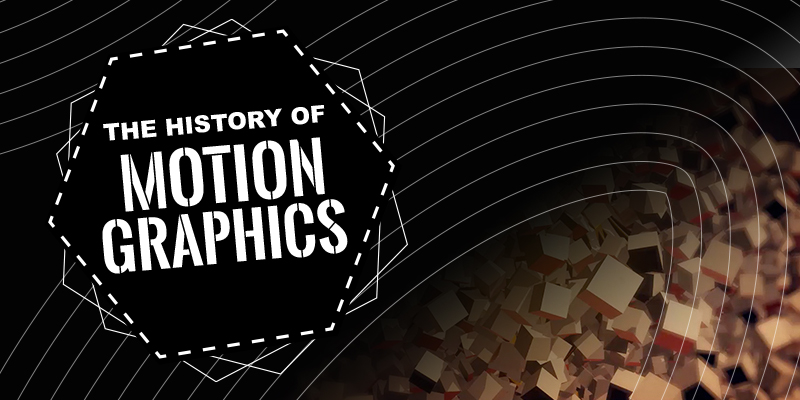
The History of Motion Graphics
The history of motion graphics goes back further than Adobe After Effects. One of the first uses of the term “motion graphics” was by animator John Whitney, who co-founded Motion Graphics, Inc. in 1960 to create motion picture and television title sequences. However, motion graphics dates back to before electronic media, sometime back in the 1800’s with presentation flipbooks.
Motion graphics, in a nutshell, is any graphics that use technology to create an illusion of motion, transformation, or rotation in order to communicate messages through video and audio storytelling. Motion graphics includes things such as films, videos, animated text, and web-based animation, among other things and the field has quickly evolved as a direct result of improvements in technology.
Beginnings of Motion Graphics
Dating back to the 1800’s, early animation devices like flip books were created to produce movement through sequential drawings, but animation didn’t really take off until the start of cinematography. The first credits of starting motion graphics and animation can’t be given to any one person in particular, as there were so many different kinds of animation projects being produced at the same time at the beginnings. Marcel Duchamp, Walter Ruttman, and Fernand Lager’s works all show great experimenting in mixing techniques and media for film. Although there is no originator in motion graphics, there were many people who were considered pioneers in the field such as Saul Bass, Pablo Ferro and John Whitney, to name a few.
Important Figures
Marcel Duchamp (1887-1968)
Marcel Duchamp had an immense impact on 20th & 21st century art, and is commonly regarded, along with Pablo Picasso and Henri Matisse, as one of the three artists who helped to define the revolutionary developments in the plastic arts. In 1926, together with Man Ray and Marc Allegrat, Duchamp filmed an experimental film named Anemic Cinema. As part of Duchamps spinning works, rotoreliefs (whirling animated drawings) were painted on flat cardboard circles and spun on a phonograph turntable. When they disks were spinning they appeared to be 3-dimensional. The film depicts the rotoreliefs alternated with spinning puns in French.
Anemic Cinema: https://vimeo.com/7733425
Walter Ruttman (1887-1941)
Ruttman was a German film director who worked mainly in experimental film. He started his film career in the early 1920’s, starting with abstract films Lichtspiel: Opus I (1921), the first publicly screened abstract film, and Opus II (1923.) The films were experiments in new forms of film expression and featured shapes of different colors flowing back and forth and in and out of the lens. The animations were painted with oil on glass plates so the wet paint could be wiped away and modified easily. They painted plates were beneath an animation camera and frames were shot after each brush stroke or alteration. The strokes were later combined with geometric cutouts on a separate glass layer.
Lichtspiel: Opus I: https://vimeo.com/42624760
Fernand Leger (1881-1955)
Fernand Leger was a French painter, sculptor, and filmmaker who was regarded as a forerunner of pop art. In 1924, Leger co-directed the iconic and Futurism-influenced Le Ballet Mecanique with filmmaker Dudley Murphy. It included a series of images of a woman’s lips and teeth, close-up shots of ordinary objects, and repeated images of human activities and rhythmic machines. The film is considered one of the masterpieces of early experimental filmmaking.
Saul Bass (1920-1996)
Saul Bass is a great name in the field of motion graphics and is a major pioneer in the development of feature film title sequences. Although he had a memorable career as a graphic designer, his film titling work and poster design is what really made him stand out. His designs were simple, but they effectively communicated the mood of the films. Some noteworthy title sequences he created were for films such as The Man With The Golden Arm (1955), Psycho (1960), Goodfellas (1990), and Casino (1995.)
Check out a brief visual history of his most celebrated work in “The Title Design of Saul Bass”: https://vimeo.com/31992143
John Whitney (1917-1995)
John Whitney is considered to be one of the fathers of computer animation. In 1960, he was one of the first to use the term “motion graphics” when he founded Motion Graphics, Inc., in order to create motion picture and television title sequences through his own mechanical analogue computer invention. One of his most famous works was the animated title sequence from Alfred Hitchcock’s film “Vertigo” in 1958, collaborating with Saul Bass, which featured swirling graphics growing from small to large.
Vertigo Title Sequence: https://www.youtube.com/watch?v=-DU0IVmBgsQ
Stan Brakhage (1933-2003)
Stan Brakhage is considered to be one of the most important figures in 20th-century experimental film. He explored a variety of formats, creating a large, diverse body of work. Some of his approaches and techniques included handheld camerawork, painting directly onto celluloid, fast cutting, in-camera editing, scratching on film, collage film, and the use of multiple exposures. You can see his influence in the credits of the film Seven (1995), designed by Kyle Cooper, with the scratched emulsion, rapid cutaways, and bursts of light in his style; this work received critical acclaim.
Pablo Ferro (1935-)
An American graphic designer and film titles designer, Pablo Ferro was a pioneer of quick-cut editing and multiple screen images animation (the first in film and television in 1963.) Winning over 70 national and international awards, his work is featured in popular films such as Philadelphia, Beetlejuice, Men in Black, and A Clockwork Orange. His titles and montage sequences have appeared in 12 Academy Award winning films.
See his design work in the compilation “Pable Ferro: A Career Retrospective”: https://vimeo.com/90413568
Norman McLaren (1914-1987)
As an animator and filmmaker, Norman McLaren was a pioneer in a number of areas of animation and filmmaking, including drawn-on-film animation, visual music, abstract film, pixilation and graphical sound. He developed a number of groundbreaking techniques for combining and synchronizing animation with music.
Kyle Cooper (1962-)
One of today’s major players in the motion graphics industry, Kyle Cooper is an American designer of motion picture title sequences. He studied under the great Paul Rand at Yale University and his work in film title design is often compared to Saul Bass. His work for the title sequence of Seven (with influences from Stan Brakhage) really raised the bar creatively, and you can see his work in other popular films such as the Spiderman Trilogy (2002, 2004, 2007), Sherlock Holmes (2009), and in popular TV shows including The Walking Dead (2010) and American Horror Story (2011.)
Se7en Title Sequence: https://vimeo.com/95739920
Motion Graphics Industry
Motion graphics is arguably one of the most sought-after art forms of the 21st century. A typical motion graphics designer is trained in traditional graphic design or comes from film or animation backgrounds. Knowledge of color, typography, imagery and sound are essential to becoming a well-rounded motion graphics artist, as well as learning the necessary software programs. As technologies have improved, the motion graphic industry has continuously evolved. Before computers were widely available, motion graphics were expensive and time-consuming. With the increasing availability of user-friendly motion graphics software, this has changed. There are so many more tools available to motion graphics artists, and although there is a decent learning curve, they are becoming easier to explore and learn.
One of the leading programs used by motion graphic designers is Adobe After Effects, which allows users to create and modify graphics over time. Adobe Flash is widely used to created motion design for the web. 3D software programs, like Maxon Cinema 4D, has integrated motion graphics tools, and works well with After Effects and Photoshop. Some of the other programs used for motion graphics include Nuke, Autodesk Combustion, Apple Motion/Shake, and 3D programs such as Autodesk 3DS Max and Maya, Newtek Lightwave, and Blender, among many others.
With improvements in technology, especially the Internet, the motion graphics industry has changed dramatically. Content creation, distribution and delivery are all very different now that designers can work from anywhere, at any time, and still meet deadlines with the use of an internet connection.
Today’s Motion Graphics Studios
There are many amazing motion graphics design studios today. Here are some resources for some of our favorites.
Addikt | Design Movement
www.addikt.tv
Working out of their offices in Amsterdam and Mumbai, Addikt is a design boutique dedicated to motion and digital design, specializing in the development of visual concepts and moving content. Some of their clients include Nike, Volkswagon, and Heineken.
Tronic Studio
www.tronicstudio.com
A New York based studio, Tronic’s work includes animation, architecture, and experiential and interactive design. Their projects move between art and advertising, and they have created work for Nike, AT&T, and Xbox.
abstract:groove
www.abstractgroove.com
Based in Milan, Italy, abstract:groove is an integrated creative, production and design studio working mainly on developing uncommon audio-visual projects in communication and advertising. They have directed projects for Diesel, Dolce&Gabbana, and Invicta.
Paul Clements
paulclements.tv
www.rocknroller.tv
www.behance.net/paulclements
Paul Clements is a motion designer/director at RockNRoller Studios. Some of his clients include MTV, Carlsberg beer, UFC, and rock band Snow Patrol.
MK12
http://mk12.com/MKXII/
A design and filmmaking collective based in Kansas City, Missouri. Their work constantly challenges the boundaries between narrative structure and experimental storytelling via juxtapositions of live action, graphic design, nostalgic influence and new technologies. Their work includes title sequence design and in-film FX for films like Quantum of Solace and Stranger than Fiction, music video’s for Hot Hot Heat and Common, and they have been involved in several game promotions including Harmonix’s Beatles and Green Day Rock Band.
Get Inspired & Learn
Motionographer
motionographer.com
Find inspiration at Motionographer, which is an all-volunteer organization run by professional artists, designers, and directors. This is a great source of outstanding work from studios, freelancers and students for filmmakers, animators, and designers and includes featured stories on the industry, commentary, and miscellaneous items that Motionographer contributors find interesting.
Greyscalegorilla
greyscalegorilla.com
Greyscalegorilla is a great resource of tools and training for 3D. The site includes tutorials and blog posts for learning Cinema 4D.
Motionworks
motionworks.net
Motionworks is a motion graphics learning resource that includes blog post inspiration, After Effects and Cinema 4D tutorials, 3D experiments, and a resource shop.
Want to learn more about motion graphics? Check out this tutorial: http://arsenal.gomedia.us/shop/video-tutorials/the-designers-guide-to-motion-graphics/


Thanks for such a insightful article regarding motion graphics.I also write a blog over “motion graohics”. Pls have a look and give your review/suggestion.
https://bit.ly/2M9it9D
Again Thanks and keep sharing the good content.
Thanks so much..
What year is this article from?
It was written in 2015.
I really love this post
Hey Ashley!
First off, thank you for this blog! I am currently at Kent State pursuing my Master’s of Art in the VCD program but I have experience in film/media from undergrad. I’ve been toying around with learning full motion design ( it’s my dream) but didn’t know where to begin! Thank you for the resources and I hope all is well!
Thank you Tyler, good to hear that you found this information useful. Best of luck with your Master’s at Kent State!
First off, thanks for this blog! I am presently at Kent State pursuing my Master’s of Art withinside the VCD application however I actually have enjoy in film/media from undergrad. I’ve been toying round with gaining knowledge of complete movement design ( it’s my dream) however didn’t understand in which to begin! Thank you for the assets and I wish all is well! Motion Graphic Design Manchester